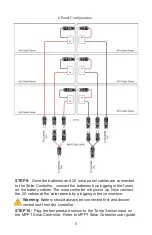
7
equipment loads to the controller load outputs. This output will discon-
nect the loads if the battery voltage drops below the preset level and
this will protect the battery from over
-
discharge. If batteries get com-
pletely discharged because the equipment was connected directly to
the battery, you will reduce the battery life and you will most likely need
to charge them with a good quality 10A automotive battery charger.
Once they are back to a normal operating range, the integrated charge
controller will maintain the charge. Don
’
t charge batteries using an au-
tomotive charger for longer than 8hrs or you may damage the battery.
7.
TROUBLESHOOTING:
A.
The display on the solar controller looks fine but the batteries
aren
’
t charging?
The solar voltage should be higher than the
battery voltage. Check to make sure Solar Panels are wired in se-
ries for 48V configuration.
B.
There is no voltage output?
If battery voltage is too low the
charge controller will turn off the load outputs. If load current is too
high the load output will turn off automatically.
C.
Why is my solar panel voltage so high?
Open circuit voltage
on a 48V panel array could be as high as 95V. This is normal.
D.
My system turns off at night and comes back on in the morn-
ing?
This is a sure sign that the solar panels and/or battery ca-
pacity can
’
t support the load. You should measure your actual
load and recalculate to make sure you have adequate solar and
battery capacity. Make sure there is no shading of solar panels
during the day. Clean panels. Check tilt.
E.
There is no power at the solar controller?
Check the battery
cable fuse. Measure battery voltage at the solar controller it
should be >9V. If less than 9V then batteries will need to be
charged with an external charger to bring the voltage up to normal
operating range of the controller.
Содержание RemotePro RPAL MPPT
Страница 3: ...3 ...


























